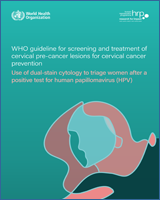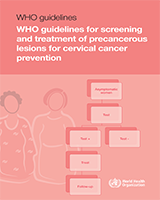Cervical intraepithelial neoplasia (CIN) is a premalignant lesion that may exist at any one of three stages: CIN1, CIN2, or CIN3.2 If left untreated, CIN2 or CIN3 (collectively referred to as CIN2+) can progress to cervical cancer. It is estimated that approximately 1–2% of women have CIN2+ each year. This rate is reported to be higher in women of HIV-positive status, at 10% (1–5). The standard practice is to screen women using cytology (Pap test), and when cytology results are positive the diagnosis of CIN is based on subsequent colposcopy, biopsy of suspicious lesions, and then treatment only when CIN2+ has been histologically confirmed. This traditional screening method requires highly trained human resources and a substantial amount of laboratory equipment. In low- and middle-income countries, because of the high cost of setting up screening programmes based on cytology, coverage of screening is very low and alternative screening methods are needed. In addition, follow-up of a positive cytology test with colposcopy and biopsy requires resources and skilled personnel that are largely lacking in many countries. Other bottlenecks in screening programmes based on cytology include the need for referral to distant health facilities for diagnostic and treatment services, and the long waiting times before cytology results are available. An alternative approach to diagnosing and treating CIN is to use a ‘screen-and-treat’ approach in which the treatment decision is based on a screening test, and not on a histologically confirmed diagnosis of CIN2+, and treatment is provided soon or, ideally, immediately after a positive screening test.
The goal of a screen-and-treat programme for cervical cancer is to reduce cervical cancer and related mortality with relatively few adverse events. The programme must include a screening test or strategy (sequence of tests) and be linked to appropriate treatments for CIN, and also provide referral for treatment of women with invasive cervical cancer. Common screening tests that are widely used include tests for human papillomavirus (HPV), cytology (Pap test), and unaided visual inspection with acetic acid (VIA). These tests can be used as a single test or in a sequence. When using a single test, a positive result indicates the need for treatment. When using a sequence of tests, women who test positive on the first test receive another test and only those who test positive on the second test are treated. Women with a positive first screening test followed by a negative second screening test are followed up. Available treatments include cryotherapy, large loop excision of the transformation zone (LEEP/LLETZ), and cold knife conization (CKC).
This guideline provides recommendations for strategies for a screen-and-treat programme. It builds upon the existing recommendations for the use of cryotherapy to treat CIN (6, 7) and on the new WHO guidelines for treatment of cervical intraepithelial neoplasia 2–3 and glandular adenocarcinoma in situ (8), which is being published concomitantly with these present guidelines. When developing the guideline, the Guideline Development Group (GDG) considered that countries currently providing screen-and-treat programmes may be uncertain about which strategy to use. Therefore, these recommendations were developed by comparing the benefits and harms of different screen-and-treat strategies. For countries where a cervical cancer prevention and control programme already exists, these recommendations were developed to assist decision-makers to determine whether to provide a different screening test followed by a different treatment instead, or to provide a series of tests followed by an adequate treatment. For countries where such a programme does not currently exist, these recommendations can be used to determine which screening test and treatment to provide. In addition, a decision-making framework is proposed in Annex 2 to help programme managers choose the right strategy based on the specific country or regional context.
The recommendations and background information about the various screening tests and treatments are also available in an updated version of Comprehensive cervical cancer control: a guide to essential practice (C4-GEP) (10). The C4-GEP was originally published in 2006 by the World Health Organization (WHO) to assist clinicians and programme managers to diagnose and treat CIN in order to prevent and control cervical cancer. In 2009, WHO committed to updating the C4-GEP as specific aspects deserved the development of new recommendations. In particular, new evidence had become available regarding the use of cryotherapy for CIN (a new guideline was completed in 2011 [7]); treatment of histologically confirmed CIN2+ (a new guideline is being published concomitantly with this present one [8]); and strategies for screening and treatment of precancerous cervical lesions (the subject of this present guidance). In addition, there is a new awareness that when making recommendations for screen-and-treat strategies, the consequences of treating or not treating women after positive or negative screening results should also be considered. Typically, the selection of a screening test is based on its accuracy, which is determined by calculating the sensitivity and specificity of the test, and recommendations are based on that evidence. However, these data, do not address the consequences of screening and treating women. When deciding on a screen-and-treat strategy, it is critical to consider the downstream consequences after treatment (for a positive test) or no treatment (for a negative test), such as cervical cancer and related mortality, recurrence of CIN2+, adverse effects of treatment (and overtreatment), and use of resources. These recommendations are based on evidence about the diagnostic accuracy of each of the screening tests, together with evidence about the benefits and harms of treatments.
Target audience
This guideline is intended primarily for policy-makers, managers, programme officers, and other professionals in the health sector who have responsibility for choosing strategies for cervical cancer prevention, at country, regional and district levels. Individuals working in reproductive health care programmes, particularly programmes for the prevention of sexually transmitted infections (STIs) including HIV/AIDS and for family planning, at the district and primary health care levels, should also consult these guidelines to understand how recommendations are developed and why it is vitally important to select and implement evidence-based strategies to prevent cervical cancer.
Purpose
This guideline provides recommendations for screen-and-treat strategies to prevent cervical cancer (Chapter 3). In addition to the recommendations, this document proposes a decision-making flowchart for choosing the best screen-and-treat strategy for a particular setting at a programme level (Annex 2); and – for use once the strategy is chosen – the screen-and-treat flowcharts for all strategies are provided, including the flowcharts specifically for women of negative or unknown HIV status (Annex 3), and those for women of HIV-positive status or of unknown HIV status in areas with areas with high endemic HIV infection (Annex 4). This document also describes the WHO methodology that was used for the development of these recommendations (Chapter 2, and Annexes 5–7), and provides GRADE (Grading of Recommendations, Assessment, Development and Evaluation) evidence profiles3 and evidence-to-recommendation tables4 for each recommendation (available online: Supplemental material, Sections A and B). This document provides the scientific background and justification for the practical information found in the C4-GEP (10).
- 2
Diagnosis of CIN is established by histopathological examination of a cervical punch biopsy or excision specimen. A judgement of whether or not a cervical tissue specimen reveals CIN, and to what degree, is dependent on the histological features concerned with differentiation, maturation and stratification of cells and nuclear abnormalities. The proportion of the thickness of the epithelium showing mature and differentiated cells is used for grading CIN. More severe degrees of CIN are likely to have a greater proportion of the thickness of epithelium composed of undifferentiated cells, with only a narrow layer of mature differentiated cells on the surface (9).
- 3
The GRADE evidence profiles summarize the evidence from the systematic reviews and the model, as well as the quality of the evidence.
- 4
The ‘evidence-to-recommendation tables’ describe the process of going from the evidence to developing the recommendations, and explain the judgements and rationale for factors that are not part of the GRADE evidence profiles.


